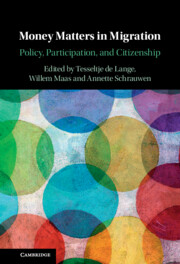Book contents
- Money Matters in Migration
- Money Matters in Migration
- Copyright page
- Contents
- Notes on Contributors
- 1 Money Matters in Migration: A Synthetic Approach
- Part I Migration
- 2 The Changing Landscape of Multilateral Financing and Global Migration Governance
- 3 Digging a Moat around Fortress Europe: EU Funding as an Instrument of Exclusion
- 4 The “Refugee Hospital”. Aid Money, Migration Politics, and Uncertain Care in Neoliberal Morocco
- 5 Cash Rules Everything: Money and Migration in the Colombian-Venezuelan Borderlands
- 6 Recruitment Fees, Indebtedness, and the Impairment of Asian Migrant Workers’ Rights
- 7 Pushing Out the Poor: Unstable Income and Termination of Residence
- 8 Follow the Money: Income Requirements in Norwegian Immigration Regulations
- Part II Participation
- Part III Citizenship
- Index
- References
8 - Follow the Money: Income Requirements in Norwegian Immigration Regulations
from Part I - Migration
Published online by Cambridge University Press: 12 November 2021
- Money Matters in Migration
- Money Matters in Migration
- Copyright page
- Contents
- Notes on Contributors
- 1 Money Matters in Migration: A Synthetic Approach
- Part I Migration
- 2 The Changing Landscape of Multilateral Financing and Global Migration Governance
- 3 Digging a Moat around Fortress Europe: EU Funding as an Instrument of Exclusion
- 4 The “Refugee Hospital”. Aid Money, Migration Politics, and Uncertain Care in Neoliberal Morocco
- 5 Cash Rules Everything: Money and Migration in the Colombian-Venezuelan Borderlands
- 6 Recruitment Fees, Indebtedness, and the Impairment of Asian Migrant Workers’ Rights
- 7 Pushing Out the Poor: Unstable Income and Termination of Residence
- 8 Follow the Money: Income Requirements in Norwegian Immigration Regulations
- Part II Participation
- Part III Citizenship
- Index
- References
Summary
Following the 2015 refugee crisis, Norwegian politicians introduced proposals to extend a family reunification income requirement to refugee sponsors and to introduce an income requirement for permanent residence. Family sponsors must make enough money to qualify; and migrants must ‘get to work’ to qualify for permanent stay. This chapter seeks to explain why one of the income requirements was implemented and the other not. It harnesses Carol Lee Bacchi’s approach to policy analysis, asking, ‘What is the problem represented to be?’ in a close reading of relevant documents. It finds the two requirements inscribed into different narratives. One narrative establishes the arrival of an unprecedented number of asylum seekers foremost as a problem for the Norwegian society and the sustainability of the welfare state. An alternative problem representation brings attention to the concrete effects of such requirements on specific groups of refugees. The analysis identifies an economic drift and stratification of migrants’ rights. It argues this drift is part of the more general development in Europe, where money has become a more important tool to regulate migration.
- Type
- Chapter
- Information
- Money Matters in MigrationPolicy, Participation, and Citizenship, pp. 130 - 146Publisher: Cambridge University PressPrint publication year: 2021
References
- 4
- Cited by



